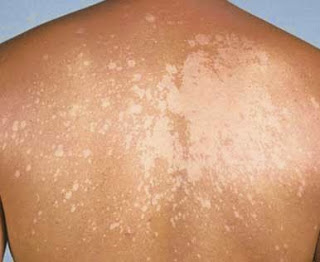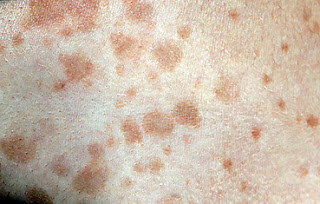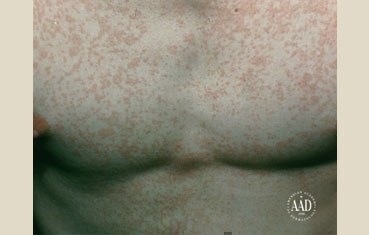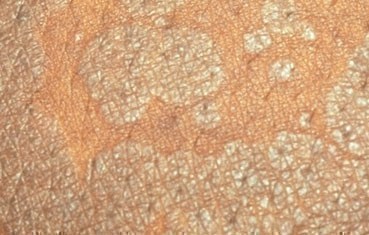Tinea versicolor (SKIN FUNGAL DISEASE) Treatment
TINEA VERSICOLOR: OVERVIEW


(Tinea versicolor: It is not harmful, but many people dislike the way it discolors their skin.)
Also called pityriasis versicolor
We all have yeast living on our skin. When they grow out of control, a person can get a skin disease called tinea versicolor.
Your dermatologist may tell you that you have a fungal infection on your skin. Yeast is a type of fungus.
Many people get tinea versicolor. It is one of the most common skin diseases in tropical and subtropical areas of the world. People who live in tropical areas may have tinea versicolor year-round.
N/B: Image used with permission of the American Academy of Dermatology National Library of Dermatologic Teaching Slides.
TINEA VERSICOLOR: SIGNS AND SYMPTOMS

(Tinea versicolor: It often looks like a rash.)
The first sign of tinea versicolor is often spots on the skin. These spots may:
- Be lighter (or darker) than your surrounding skin. The color of the spots can be white, pink, salmon, red, tan, or brown.
- Appear anywhere on the body.
- Be dry and scaly.
- Cause the affected skin to itch.
- Become more noticeable when you have a tan (the yeast prevents the skin from tanning).
- Grow slowly.
- Grow together, forming patches of lighter (or darker) skin.
- Disappear when the temperature drops and return in the spring or summer when the air turns warm and humid.

Sometimes the spots are so faint that people do not realize they have tinea versicolor. If tinea versicolor causes light spots on the skin, it can be mistaken for vitiligo. Vitiligo is a skin disease that causes the skin to lose its natural color.
Images used with permission of the American Academy of Dermatology National Library of Dermatologic Teaching Slides.
TINEA VERSICOLOR: WHO GETS AND CAUSES
Who gets tinea versicolor?
The yeast that causes tinea versicolor lives on everyone's skin. It is not clear why the yeast overgrows on some people's skin and not others. We do know the following about tinea versicolor:
- People of all skin colors get it.
- Teens and young adults are most susceptible because they have oily skin.
- Older adults and children rarely get it unless they live in a tropical or subtropical area.
- People who live in non-tropical areas often see tinea versicolor disappear during the cool, dry months.
What causes tinea versicolor?
Yeast normally live on our skin. When the yeast overgrows, it causes the skin disease tinea versicolor. It is believed that the following can cause the yeast to overgrow:
- Hot, humid weather.
- Lots of sweating.
- Oily skin.
- A weakened immune system.
TINEA VERSICOLOR: DIAGNOSIS AND TREATMENT
How do dermatologists diagnose tinea versicolor?
A dermatologist can often look at the skin and tell whether a patient has tinea versicolor. If there is any doubt, the dermatologist will do one of the following to make an accurate diagnosis:
- Scrape off a bit of the skin. This will be examined under a microscope.
- Look at the skin with a special device called a Wood's lamp. The dermatologist will hold the Wood's lamp about 4 or 5 inches from the affected skin. If the patient has tinea versicolor, the affected skin appears yellowish green in color when looked at with this lamp.
How do dermatologists treat tinea versicolor?
What a dermatologist prescribes depends on several things. These include where the tinea versicolor appears on your body, how much skin has tinea versicolor, how thick the spots have grown, and the climate.
Treatment for tinea versicolor may include:
- Medicine applied to the skin: This is the most common treatment. There are anti-fungal shampoos, soaps, creams, and lotions that can keep the yeast under control. The active ingredient in these medicines is often selenium sulfide, ketoconazole, or pyrithione zinc.
- Medicated cleansers: Tinea versicolor often returns, especially when a person lives in a place that is warm and humid. Using a medicated cleanser once or twice a month, especially during warm and humid periods, can prevent the yeast from overgrowing again.
- Anti-fungal pills: A dermatologist may prescribe these pills if the tinea versicolor covers a large area of the body, is thick, or often returns after it is treated. These pills are taken for a short time. During this time, your dermatologist will monitor you.
Outcome
With treatment, the yeast is easy to kill. The skin, however, may stay lighter (or darker) for weeks or months. The skin will eventually return to its normal color. To help even out your skin tone, you should protect your skin from the sun and not tan.
Tinea versicolor can return. When the air outdoors is warm and humid, the yeast can quickly grow out of control. Some people who live in a tropical climate may need to use a medicated cleanser year round to prevent the yeast from overgrowing. People who live in an area that becomes warm and moist each spring may see tinea versicolor return every year.
TINEA VERSICOLOR: TIPS FOR MANAGING
If tinea versicolor is mild, you may be able to treat it yourself. There are anti-fungal products that you can buy without a prescription. These include:
- Shampoo that contains selenium sulfide.
- Anti-fungal cream or ointment that contains miconazole, clotrimazole, or terbinafine.
When using these products, dermatologists recommend the following:
- Wash and dry the affected skin.
- Apply a thin layer of the anti-fungal cream or ointment. Do this once or twice a day for at least 2 weeks.
- When using a shampoo, leave it on your scalp for 5 or 10 minutes before rinsing.
Some people need stronger medicine, so they see a dermatologist. Whether you decide to self-treat or see a dermatologist, these tips can help you get better results:
- Stop using skin care products that are oily. Use products that are oil-free. The label may also read "non-comedogenic."
- Wear loose clothes. Nothing should feel tight.
- Protect your skin from the sun. A tan makes tinea versicolor easier to see.
- Do not use a tanning bed or sun lamp. Again, a tan makes tinea versicolor easier to see.
How to protect your skin from the sun
To get the best results, you need to protect your skin from the sun. To do this, you should apply sunscreen every day. Be sure to apply the sunscreen 20 minutes before you go outside. And apply it to all skin that will not be covered by clothing. Make sure to use a sunscreen that offers:
- UVA and UVB protection (label may say broad-spectrum).
- Sun Protection Factor (SPF) of 30 or higher.
- Non-greasy formula (label may read "oil-free" or "non-comedogenic").
💪
Ready to take the next step in mastering your arousal and Cure your Premature Ejaculation? 👇
Get Your Copy of Mastering Your ArousalUnlock lasting control and confidence in your intimate life.
Related Posts
Trending Articles
Search Now
Recent Posts
- Can Lidocaine Numbing Gel Help with Premature Ejaculation?
- Understanding and Controlling Involuntary Kegels (Contractions) During Sex
- Why the Transition to Sex Can Be So Challenging After Premature Ejaculation Training?
- Why Setbacks Happen: The Truth About Orgasm During Your PE Recovery Journey
- I Prematurely Ejaculated in my Girlfriend while Trying to cure my premature ejaculation using the Guide
Categories
- Premature Ejaculation
- Question & Answer
- Diseases
- Drugs
- Loans
- Insurance
- Health
- Hospital
- Lifestyle
- News
- Know How
- Education
- Travel
Comments (0)
Leave a Comment